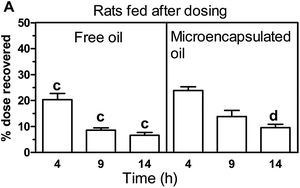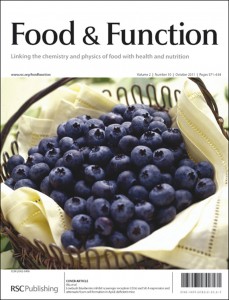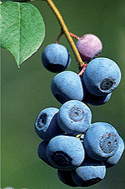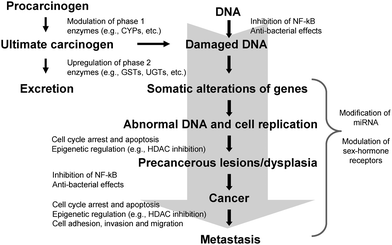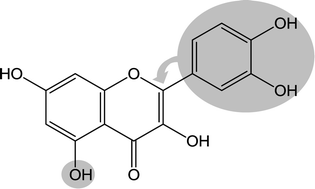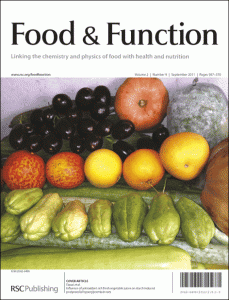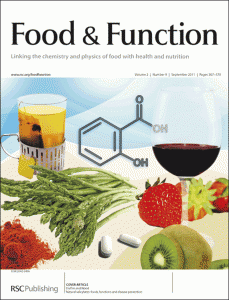This month sees the following articles in Food & Function that are in the top ten most accessed:-
Transcription profiles of LPS-stimulated THP-1 monocytes and macrophages: a tool to study inflammation modulating effects of food-derived compounds
Wasaporn Chanput, Jurriaan Mes, Robert A. M. Vreeburg, Huub F. J. Savelkoul and Harry J. Wichers
Food Funct., 2010, 1, 254-261, DOI: 10.1039/C0FO00113A
Anti-inflammatory activity of natural dietary flavonoids
Min-Hsiung Pan, Ching-Shu Lai and Chi-Tang Ho
Food Funct., 2010, 1, 15-31, DOI: 10.1039/C0FO00103A, Review
Safety assessment of plant food supplements (PFS)
Suzanne J. P. L. van den Berg, Lluis Serra-Majem, Patrick Coppens and Ivonne M. C. M. Rietjens
Food Funct., 2011, Advance Article, DOI: 10.1039/C1FO10067J
Bioactive peptides derived from milk proteins and their health beneficial potentials: an update
Ravinder Nagpal, Pradip Behare, Rajiv Rana, Ashwani Kumar, Manoj Kumar, Sanu Arora, Fransesco Morotta, Shalini Jain and Hariom Yadav
Food Funct., 2011, 2, 18-27, DOI: 10.1039/C0FO00016G
Review of in vitro digestion models for rapid screening of emulsion-based systems
David Julian McClements and Yan Li
Food Funct., 2010, 1, 32-59, DOI: 10.1039/C0FO00111B
Development of a simple model device for in vitro gastric digestion investigation
Jianshe Chen, Vishwajeet Gaikwad, Melvin Holmes, Brent Murray, Malcolm Povey, Ye Wang and Ying Zhang
Food Funct., 2011, 2, 174-182, DOI: 10.1039/C0FO00159G
Conjugated quercetin glucuronides as bioactive metabolites and precursors of aglycone in vivo
Junji Terao, Kaeko Murota and Yoshichika Kawai
Food Funct., 2011, 2, 11-17, DOI: 10.1039/C0FO00106F
Effects of O-methylated metabolites of quercetin on oxidative stress, thermotolerance, lifespan and bioavailability on Caenorhabditis elegans
Felipe Surco-Laos, Juan Cabello, Eva Gómez-Orte, Susana González-Manzano, Ana M. González-Paramás, Celestino Santos-Buelga and Montserrat Dueñas
Food Funct., 2011, 2, 445-456, DOI: 10.1039/C1FO10049A
Red wine: A source of potent ligands for peroxisome proliferator-activated receptor γ
Alfred Zoechling, Falk Liebner and Alois Jungbauer
Food Funct., 2011, 2, 28-38, DOI: 10.1039/C0FO00086H
The metabolism and analysis of isoflavones and other dietary polyphenols in foods and biological systems
Stephen Barnes, Jeevan Prasain, Tracy D’Alessandro, Ali Arabshahi, Nigel Botting, Mary Ann Lila, George Jackson, Elsa M. Janle and Connie M. Weaver
Food Funct., 2011, 2, 235-244, DOI: 10.1039/C1FO10025D
Why not take a look at the articles today and blog your thoughts and comments below.
Fancy submitting an article to Food & Function? Then why not submit to us today or alternatively email us your suggestions.
Comments Off on Top ten most accessed articles in August
 There is increasing evidence to show that dietary fatty acids play an important role in modulating hypertriglyceridemia in the postprandial state, which contributes to the pathogenesis of type 2 diabetes, atherosclerosis, coronary heart disease and stroke. In this review, by Francisco Muriana and colleagues, the potential of dietary monounsaturated fatty acids (MUFA), polyunsaturated fatty acids (PUFA), and saturated fatty acids (SFA) to postprandially affect metabolic abnormalities related to chronic diseases is discussed.
There is increasing evidence to show that dietary fatty acids play an important role in modulating hypertriglyceridemia in the postprandial state, which contributes to the pathogenesis of type 2 diabetes, atherosclerosis, coronary heart disease and stroke. In this review, by Francisco Muriana and colleagues, the potential of dietary monounsaturated fatty acids (MUFA), polyunsaturated fatty acids (PUFA), and saturated fatty acids (SFA) to postprandially affect metabolic abnormalities related to chronic diseases is discussed.










